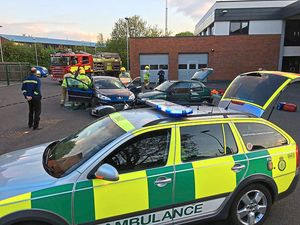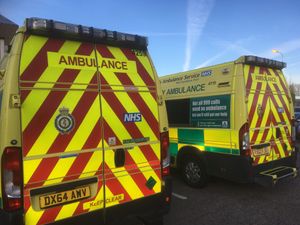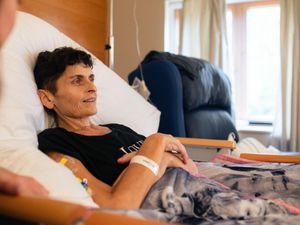Staffordshire first responders shake-up 'will help service recruit more volunteers'
Removing blue lights and drug responsibilities will lead to rise in volunteers, say ambulance bosses.

Ambulance bosses say changes to the way first responders operate in Staffordshire could lead to a boost in the number of volunteers joining the service.
Community First Responders in the county will be stripped of blue lights and will no longer be able to carry certain drugs from April 1 as part of a move to improve patient safety.
The changes will see CFRs trained to a regulated national qualification, which it is hoped will make the service more accessible to volunteers.
But it is opposed by some first responders, who say the changes are “a major backward step”.
A number of ‘enhanced’ first responders in the county have cars fitted with blue lights, and carry drugs including Glyceryl trinitrate, Aspirin, Adrenalin and Salbutamol.
West Midlands Ambulance Service spokesman Murray MacGregor said a change to the Road Safety Act 2006, due later this year, will block the usage of blue lights.
Figures released by the ambulance service show the service dealt with 200,000 cases last year, 5,198 of which saw CFRs on the scene.
Of those cases drugs were administered on 117 occasions to 98 patients.
Mr MacGregor said: “We are not saying that these people did not benefit from the drugs, but we are talking about a tiny proportion of people.
"The primary purpose of CFRs is to assist patients in cardiac arrest, and the drugs they carry are not life-saving.”
He added: “CFRs provide a vital service and we want to see those numbers grow.
"We know people have been put off from volunteering in Staffordshire because of the enhanced nature of some of the work CFRs there do.
“We expect to see a rise in the number of people putting themselves forward as CFRs.”
Lee Washington, an ex-Staffordshire general manager for the ambulance service said: “These changes will surely further dilute the ambulance response provision to rural communities.”
WMAS has not trained any new CFRs for two years.
'Even a minute can mean the difference between life and death'
Community first responders (CFRs) in Staffordshire say they are being “downgraded” by changes to their service, which will see them unable to use blue lights or administer drugs to patients from April 1.
It forms part of West Midlands Ambulance Service (WMAS) plans – which include a formal qualification – that bosses insist will enhance the scheme in a bid to increase the number of CFRs across the region.
The changes will impact a number of specially trained ‘enhanced’ CFRs in Staffordshire (around 10 per cent of all WMAS first responders), which are the only ones in the country allowed to use blue lights and carry drugs.
They say using blue lights enables them to bypass traffic when responding to calls, reducing journey times and increasing the chances of them being able to help patients.
Mark Walker, the group co-ordinator for Lichfield Trent Valley CFRs, said the removal of blue lights could potentially have dire consequences for patients as response times would increase.
He said this was particularly problematic in rural areas across the county where roads were frequently gridlocked.
“We were a time asset, but we won’t be able to achieve these times now,” he added.
Bosses at WMAS say they have no influence over the issue, arguing that they are bringing forward a change which is due to become legislation later this year anyway.
“We are implementing this change in a very sensible, planned way to make sure everything is in place for when it starts,” said Murray MacGregor, a spokesman for WMAS.
Mr MacGregor also believes the removal of drugs from CFR vehicles will not have a detrimental impact to the service.
Currently, ‘enhanced’ CFRs carry the following drugs:
Glyceryl trinitrate (GTN) – a spray used to relieve chest pain
Aspirin – given to heart attack patients;
Adrenalin – generally used for people who suffer from Anaphylaxis, a serious allergic reaction which can be caused by insect bites or food. It was administered three times last year in the WMAS area.
Salbutamol – administered to people suffering with breathing problems. Used 39 times in the WMAS area last year.
Entonox – basic pain relief ‘gas and air’.
Mr MacGregor said that none of the drugs in question were “life saving”.
He claimed that Entonox was “not necessary” as most people have pain relief such as paracetamol and ibuprofen in their homes, while Anaphylaxis sufferers will generally carry an EpiPen which can provide the same assistance as adrenalin.
Drugs were administered to 98 patients in the WMAS area in 2019, and Mr MacGregor says removing them from CFRs will have no impact on their ability to save lives.
This was due in part, he said, to fast back up times – the period between the arrival of the CFR and the ambulance – which averages at around 14 minutes for a category two call in the West Midlands.
He also claimed administering drugs involved “a pile of paperwork” and said they were used so rarely that it was difficult to keep CFRs up-to-date in the required training.
“Having good clinical guidance protects the public and CFRs, which has got to be a positive thing,” he added.
Mr Walker has disputed the claims.

He said: “Personally I feel the changes are degrading us as a service,” adding: “We’ve been told that they are going to enhance the schemes, but for this enhancement they are actually taking our enhanced capabilities from us, which means we lose our drugs and we’re losing our blue light as well.
“When someone is in cardiac arrest, even a minute can mean the difference between life and death.”
CFRs also point out that back up times are likely to be far higher in Staffordshire than they are in urban areas of the region.
Lee Washington, a former Staffordshire general manager for WMAS, has warned that the changes could see ambulance services failing to meet patient needs in rural communities.
He said: “The purpose of having Community First Responders was to provide rapid first strike life support and first aid treatment, to their local rural community whilst the ambulance responders were enroute.
“They play an integral part in the provision of pre hospital treatment for ill and injured patients. These changes will surely further dilute the ambulance response provision to rural communities.”
He added: “It is such a tragedy to see the dilution of the service and slowly our ambulance service, instead of being on the cutting edge of pre-hospital provision, returning to the 1970s era where the sole response was an ambulance to the rural communities, and hence that response was subject to ambulance availability, distance to travel, and traffic conditions.”
As far as WMAS is concerned, the changes, which are due to come in on April 1, could see people in Staffordshire who were previously put off by the enhanced nature of the service volunteer as CFRs.
According to Mr MacGregor this could boost the number of CFRs in the West Midlands from its current level of around 500.
They will be tasked with focusing on heart attack and cardiac arrest calls, which currently make up around half of all calls they attend.
WMAS is understood to have stopped training enhanced CFRs around four years ago.





